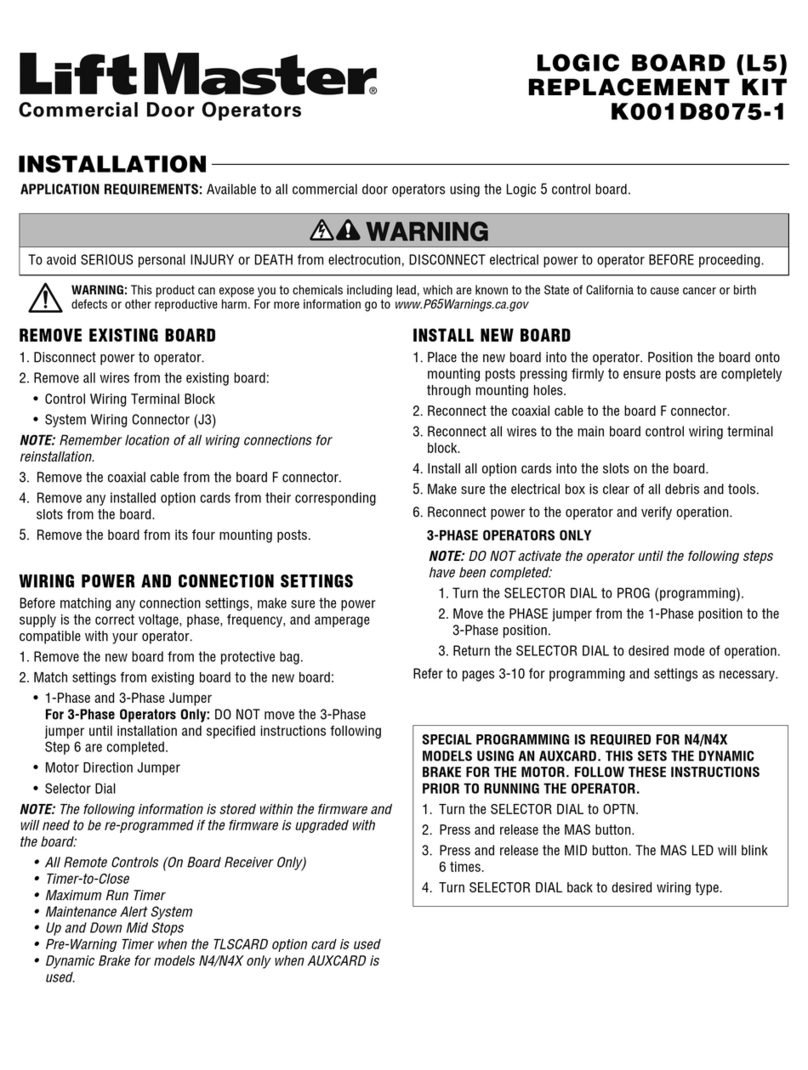
5
THREE BUTTON REMOTE CONTROL PROGRAMMED FOR OPEN/
CLOSE/STOP
NOTE: The following programming requires a LiftMaster Monitored
Entrapment Protection (LMEP) device.
Your Security+ 2.0®or dip switch remote control can be
programmed to operate as a 3-button wireless control station:
the large button will open the door, the middle button will close
the door, and the third button will stop the door’s movement.
You may set up this feature as follows:
1. To enter programming press and release the RADIO button on
the logic board (the RADIO LED will light).
2. To program the OPEN button to a remote control press and
release the OPEN button on the logic board. The RADIO LED
will flash and then stay on solid. Then press the corresponding
button on the remote control. The RADIO LED on the logic
board will flash, this confirms that the remote control has been
programmed. (By programming the remote you use 1 channel
of the 90 channels on the radio receiver.)
3. To program the CLOSE button to a remote control press and
release the CLOSE button on the logic board. The RADIO LED
will flash and then stay on solid. Then press the corresponding
button on the remote control. The RADIO LED on the logic
board will flash, this confirms that the remote control has been
programmed. (By programming the remote you use 1 channel
of the 90 channels on the radio receiver.)
4. To program the STOP button to a remote control press and
release the STOP button on the logic board. The RADIO LED
will flash and then stay on solid. Then press the corresponding
button on the remote control. The RADIO LED on the logic
board will flash, this confirms that the remote control has been
programmed. (By programming the remote you use 1 channel
of the 90 channels on the radio receiver.)
5. After learning remote controls press the RADIO button on the
logic board (RADIO LED will turn off). NOTE: If no activity
within 30 seconds, the MAS and RADIO LED’s will flash briefly
to indicate the RADIO has exited the programming mode for
remote controls and keyless entry devices. The RADIO will
remain in program mode for another 150 seconds for MyQ®
devices and then will completely exit with no activity.
Open
Close
Stop
REMOTE CONTROL PROGRAMMING FEATURE
Program Remote Controls from the 3-button control station
(3BCS).
This feature allows the user to add additional remote controls from
the 3BCS. By default the remote control learn option is off.
NOTE: Requires access to the operator electrical box to enable or
disable this feature.
To turn this feature on:
1. Turn the selector dial to PROG.
2. Press and release the RADIO button. The RADIO LED will be lit.
3. Press and release the MID button. The RADIO LED will flash
quickly 6 times.
4. Press and release the RADIO button. The RADIO LED will turn
off.
5. Return the selector dial to the desired wiring type.
To add remote controls from the 3BCS:
1. With the door in the fully closed position (close limit activated),
press and hold STOP.
2. While holding STOP, press and hold CLOSE.
3. While holding STOP and CLOSE, press and hold OPEN.
4. Release all three buttons once the MAS LED has lit.
5. Learn a remote control by one of the following methods:
a. Programming a standard single button/single function
remote control, push and hold the remote control button
until the MAS LED goes out. Repeat steps 1 through 4 to
add additional remote controls.
b. Programming a 3-button/three function remote control
(open/close/stop), first push the button on the 3BCS
(Example: OPEN) and then press and hold the button
on the remote control (Example: large button) that you
want to correspond with the selected (Example: OPEN)
command until the MAS LED flashes and goes out.
Repeat steps 1 through 4 to add additional buttons (close
and stop).
To turn this feature off:
1. Turn the selector dial to PROG.
2. Press and release the RADIO button. The RADIO LED will be lit.
3. Press and release the MRT button. The RADIO LED will flash
quickly 3 times.
4. Press and release RADIO button. The RADIO LED will turn off.
5. Return selector dial to desired wiring type.
NOTE: Restoring the operator to Factory Default (see RESETTING
FACTORY DEFAULTS) will also disable this feature. The remote
controls will still be learned.





























